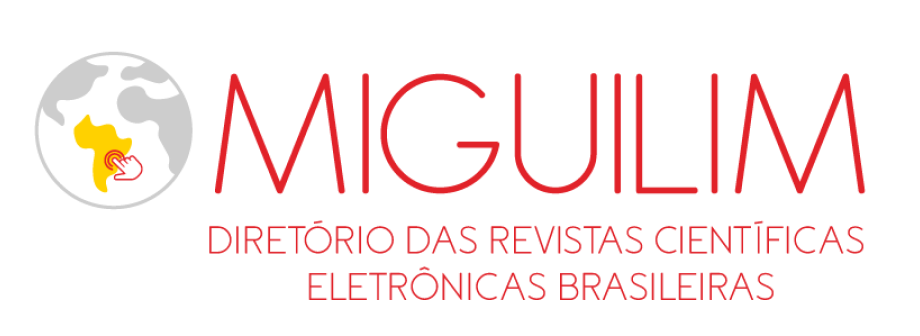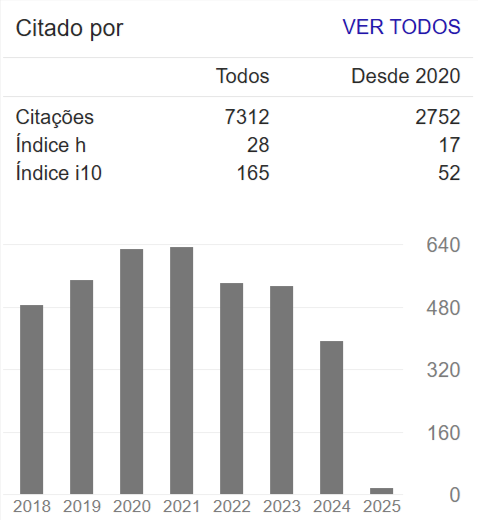Comparação de métodos para avaliar a acurácia da incorporação de dados químicos censurados na análise estatística descritiva de águas subterrâneas contaminadas
Resumo
Análises químicas da água subterrânea frequentemente apresentam conjuntos de dados com valores censurados, ou seja, abaixo do limite de detecção (LD). Quando a proporção de valores censurados é significativa, a análise geoquímica descritiva (média, mediana e desvio padrão) ou a exploratória podem ser prejudicadas e ignorar tais dados ou substituí-los por algum valor pré-determinado nem sempre é a alternativa recomendável. Assim, neste trabalho objetiva-se investigar a aplicabilidade de quatro métodos na estimativa de dados químicos censurados de uma área com águas subterrâneas contaminadas. Foram empregados três métodos estatísticos: paramétrico (Estimativa de Máxima Verossimilhança, MLE), não paramétrico (Kaplan-Meier, KM) e robusto (Métodos de Regressão na Ordem, ROS), além do método tradicional de substituição direta de dados censurados, utilizando o LD/2. O MLE, admitindo uma distribuição gaussiana dos dados (MLE-no), rendeu fatores de substituição admissíveis, próximos a 0,5, à semelhança do método tradicional de substituição (LD/2). A validação com conjuntos de dados completos com os mesmos métodos de estimativa e considerando três LD artificiais atestou os bons resultados de MLE-no e ROS com 25% e 50% de dados censurados, respectivamente, bem como de LD/2. Acredita-se que os dois primeiros métodos sejam preferíveis ao LD/2, por serem estatisticamente baseados. Recomenda-se em estudos futuros que tais métodos de estimativa sejam combinados com outros tratamentos geoestatísticos para melhorar a análise espacial de conjuntos de dados hidroquímicos.
Referências
ANTWEILER, R.C., TAYLOR, H.E. Evaluation of statistical treatments of left-censored environmental data using coin-cident uncensored data sets: I. Summary statistics. Envi-ronmental Science & Technology, v. 42, p. 3732–3738, 2008. https://doi.org/10.1021/es071301c
ANTWEILER, R.C., 2015. Evaluation of Statistical Treatments of Left-Censored Environmental Data Using Coincident Un-censored Data Sets. II. Group Comparisons. Environmental Science & Technology, v. 49, p. 13439-13446, 2015 https://doi.org/10.1021/acs.est.5b02385
BACELLAR L.A.P., OLIVEIRA FILHO W.L. Caracterização defini-tiva da pluma de contaminação das águas subterrâneas da área do aterro sanitário da CTRS-BR040. Unplubished report, Belo Horizonte, 2009.
BARELLA, C.F., BACELLAR, L.A.P., NALINI, H.A. Influence of the natural oxidation of the leachate organic fraction from a landfill on groundwater quality, Belo Horizonte: Minas Ge-rais, south-eastern Brazil. Environ Earth Sci, v. 70, p. 2283–2292, 2013. https://doi.org/10.1007/s12665-013-2284-4
BACCARELLI, A. et al. Handling of dioxin measurement data in the presence of non-detectable values: overview of availa-ble methods and their application in the Seveso chloracne study. Chemosphere, v. 60, n. 7, p. 898-906, 2005.
https://doi.org/10.1016/j.chemosphere.2005.01.055
CARRANZA, E.J.M. Analysis and mapping of geochemical anomalies using logratio-transformed stream sediment data with censored values. J. Geochem. Explor. v. 110, n. 2, p. 167-185, 2011. https://doi.org/10.1016/j.gexplo.2011.05.007
CLARKE, J. U. Evaluation of Censored Data Methods To Allow Statistical Comparisons among Very Small Samples with Below Detection Limit Observations. Environmental Science & Technology v. 32, p. 177-183, 1998.
https://doi.org/10.1021/es970521v
COHEN, A.C. Tables for maximum likelihood estimates: sin-gly truncated and singly censored samples. Technometrics, v. 3, p. 535–541, 1961. https://doi.org/10.1080/00401706.1961.10489973
CROGHAN, C. W., EGEGHY, P. P. Methods of dealing with values below the limit of detection using SAS. Southeastern SAS User Group September, p. 22-24, 2003.
FIÉVET, B., VEDOVA, D.C. Dealing with non-detect values in time series measurements of radionuclide concentration in the marine environment. Journal Environmental Radioactive v. 101, n. 1, p. 1-7, 2010. https://doi.org/10.1016/j.jenvrad.2009.07.007
FISHER, R.A. Theory of statistical estimation. In: MATHEMAT-ICAL PROCEEDINGS OF THE CAMBRIDGE PHILOSOPHICAL SOCIETY. Cambridge University Press, p. 700–725, 1925. https://doi.org/10.1017/S0305004100009580
GIBBONS, R.D. Statistical methods for detection and quanti-fication of environmental contamination. United States: John Wiley & Sons, 2001.
GILLIOM, R.J., HELSEL, D.R. Estimation of distributional parameters for censored trace level water quality data: 1. Estimation techniques. Water Resources Research, v. 22, p. 135–146, 1986. https://doi.org/10.1029/WR022i002p00135
HELSEL, D.R. Insider censoring: distortion of data with non-detects. Human and Ecological Risk Assessment, v. 11, p. 1127–1137, 2005. https://doi.org/10.1080/10807030500278586
HELSEL, D.R. Fabricating data: how substituting values for nondetects can ruin results, and what can be done about it. Chemosphere, v. 65, p. 2434–2439. https://doi.org/10.1016/j.chemosphere.2006.04.051
HELSEL, D.R. Statistics for censored environmental data using Minitab and R. Second Edition. United States: John Wiley & Sons, 2011. https://doi.org/10.1002/9781118162729
HEWETT, P., GANSER, G.H. A comparison of several methods for analyzing censored data. Annals of Occupational Hygiene v. 51, p. 611-632, 2007.
HORNUNG, R.W., REED, L.D. Estimation of average concen-tration in the presence of nondetectable values. Applied occupational and environmental hygiene, v. 5, p. 46–51, 1990. https://doi.org/10.1080/1047322X.1990.10389587
KAPLAN, E.L., MEIER, P. Nonparametric estimation from incomplete observations. Journal of the American Statistical association, v. 53, p. 457–481, 1958. https://doi.org/10.1080/01621459.1958.10501452
KROLL, C.N., STEDINGER, J.R. Estimation of moments and quantiles using censored data. Water Resources Research, v. 32, p. 1005–1012, 1996. https://doi.org/10.1029/95WR03294
LEE, L. NADA: Nondetecs and Data Analysis for Environmen-tal Data. R Package, 2010.
LEE, L., HELSEL, D. Baseline models of trace elements in major aquifers of the United States. Applied Geochemistry, v. 20, n. 8, p. 1560-1570, 2005. https://doi.org/10.1016/j.apgeochem.2005.03.008
LEITH, K.F. et. al. A comparison of techniques for assessing central tendency in left-censored data using PCB and pp'DDE contaminant concentrations from Michigan's Bald Eagle Biosentinel Program. Chemosphere, v. 80, p. 7-12, 2010. https://doi.org/10.1016/j.chemosphere.2010.03.056
LEVITAN, D.M., SCHREIBER, M.E., SEAL, R.R., BODNAR, R.J., AYLOR J.G. Developing protocols for geochemicalbaeline studies: An exemple from the Cole Hill uranium deposit, Virginia, USA. Applied Cheochemistry, v. 43, p. 88-100, 2014. https://doi.org/10.1016/j.apgeochem.2014.02.007
LIU, S., LU, J.C., KOPLIN, D. W., MEEKER, W. Q. Analysis of environmental data with censored observations. Environ-mental Science & Technology, v. 31, p. 3358-3362, 1997. https://doi.org/10.1021/es960695x
REIMANN, C. Statistical data analysis explained: applied environmental statistics with R. United States: John Wiley & Sons, 2008. https://doi.org/10.1002/9780470987605
SANFORD, R.F., PIERSON, C.T., CROVELLI, R.A.. An objective replacement method for censored geochemical data. Math-ematical Geology, v. 25, p. 59–80, 1993. https://doi.org/10.1007/BF00890676
SINGH, A., NOCERINO, J. Robust estimation of mean and variance using environmental data sets with below detection limit observations. Chemometrics and Intelligent Laboratory Systems, v. 60, p. 69-86, 2002. https://doi.org/10.1016/S0169-7439(01)00186-1
TEMPL, M., FILZMOSER, P., REIMANN, C. Cluster analysis applied to regional geochemical data: problems and possibil-ities. Applied Geochemistry, v. 23, p. 2198–2213, 2008. https://doi.org/10.1016/j.apgeochem.2008.03.004
THODE, H.C. Testing for normality. First Edition. United States: CRC press, 2002. https://doi.org/10.1201/9780203910894
YOUNG, K.D., MENEGAZZI, J.J., LEWIS, R.J. Statistical meth-od: IX. Survival analysis. Academic emergency medicine, v. 6, p. 244–249, 1999. https://doi.org/10.1111/j.1553-2712.1999.tb00165.x

















